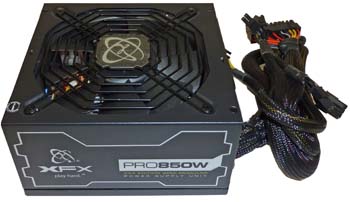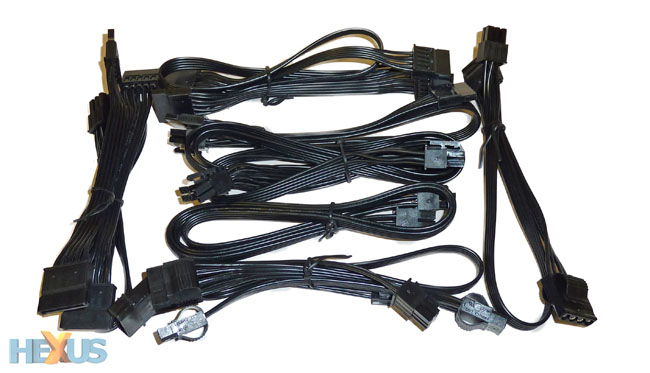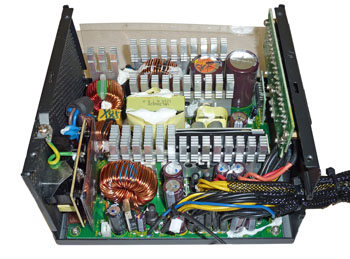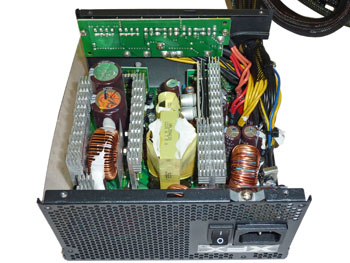Focussing on the mainstream
We last took a look at an XFX PSU in the form of the range-topping ProSeries 1,250W. Above-average performance and solid construction left us with a positive impression and that very PSU is now available for just under £200.
But as we've said on numerous occasions, such is the power efficiency of the latest components from Intel, AMD, and NVIDIA, that 1kW-plus supplies are really only needed by a very small proportion of enthusiasts. A case in point is the 233W under-load system-wide power-draw from a complete PC housing an Intel Core i7-3770K chip and GeForce GTX 680 4GB graphics card.
PSU manufacturers are realising that building high-quality 500-850W supplies is where the bulk of the enthusiast market is at. XFX looks to zero-in on this territory with the launch of 'value-orientated' semi-modular PSUs.
As it stands at the time of writing, all but one of XFX's 15 PSUs fall into what the firm calls its Pro Series, which takes in wattages from 450W to 1,250W - something for everyone. XFX has historically described its value offerings as the Core Edition, while the better, more expensive supplies go by the sub-name of Black Edition. A slew of new PSUs augment the catalogue and now go by the name of XXX Edition Semi-Modular.
Available as 650W (£70), 750W (£80), and 850W (£90) models the two higher-capacity models are, somewhat confusingly, further subdivided into 80 PLUS Bronze and Silver-rated categories. Our review PSU is the 850W Semi-Modular Bronze (P1-850X-XXB9) though a Silver model (P1-850B-UKB9) can also be purchased.
Initial impressions are favourable, as the PSU is well-packaged and, once removed, looks and feels like a premium product. The central section is dominated by a 135mm fan from ADDA. Measuring 150mm x 170mm x 86mm (WxDxH) the 850W model is a standard-sized unit.
The 'Semi-Modular' name derives from having three captive cables supplemented by six peripheral/graphics that can be added on a cable-by-cable basis through the modular plugs on the front of the supply.
The Pro Series' captive cables include a 55cm main ATX (24-pin, non-splitable), a 60cm motherboard 8-pin (4+4-pin) and 55cm PCIe that has two 6+2-pin connectors on it. You could conceivably power a complete system from it, assuming an mSATA SSD is used, though most will need to resort to the modular cabling for at least one of the PC's peripheral devices.
XFX bundles in a further seven modular cables, meaning that not all can be used concurrently. The entire shebang unfurls as follows:
| Cables | Cables, type, length, plugs on cable | |||||||
|---|---|---|---|---|---|---|---|---|
| Main | 24-pin (55cm) captive | |||||||
| ATX/EPS | 4+4-pin (60cm) captive | ATX/EPS 2 | 8-pin (60cm) modular | PCIe | 2x 6+2-pin (55-60cm) captive 2x 6+2-pin (55-60cm) modular |
|||
| Peripheral 1 | 2x SATA (30-45cm) modular | |||||||
| Peripheral 2 | 4x SATA (40-75cm) modular | Peripheral 3 | 4x SATA (40-75cm) modular | Peripheral 4 | 3x Molex (40-60cm) modular | Peripheral 5 | 2x Molex (30-45cm) modular | |
XFX provides four 6+2-pin PCIe plugs - two modular, two captive - to run at least a couple of high-end graphics cards. A total of 10 SATA, split over three cables, makes sense, and five Molex should be enough for most mid-range builds. We like the fact that short cables - 30-45cm - are bundled for systems whose storage and optical drives are located close to the PSU. What's more, the cables are flat and have easy-pull connectors, making attaching and removing Molex plugs nice and straightforward. A small Molex-to-Floppy cable caters for users who still use the archaic storage.
Peeking inside shows XFX continues to use a Seasonic platform for the PSU's innards. First-step filtering, for EMI suppression, is good, easily meeting the minimum requirements. The active power-factor-correction (PFC) output is filtered by two 400V, 330uF, 105°C-rated caps from Rubycon, shown at top of the left-hand picture.
In common with high-quality supplies, XFX's minor rails - 3.3V and 5V - are derived by tapping into the 12V's. This is referred to as a DC-to-DC design and is one method by which to increase overall PSU efficiency a touch. Soldering is decent enough and XFX plays it safe by opting for a tried-and-trusted platform.
A feature we've come to like on modern PSUs is a hybrid-fan mode, where the supply is silent at usually up to 25 per cent load. XFX doesn't implement such a feature here, unfortunately, and though there's no reason to suspect the fan will be loud at low-load levels, it doesn't cost much more to implement a silent-fan setting.
| Amps/watts and voltage | 3.3V | 5V | 12V1 | -12V | -5VSB | |||
|---|---|---|---|---|---|---|---|---|
| Rail amps | 25A |
25A |
70A |
0.5A |
3A |
|||
| Maximum rating | 150W |
840W |
6W |
15W |
||||
| Maximum rating continuous | 850W @ 50°C |
|||||||
A look at the specs shows XFX uses a single 12V rail, dubbed EasyRail Plus in marketing-speak. This means you don't have to worry about overloading a particular line if connecting high-wattage graphics cards on to one cable. The supply is also rated to provide a continuous 850W at an ambient temperature of 50°C - lesser supplies often reduce this ambient-rating figure.
Backed up by a two-year warranty in the first instance, upgradable to five years by registering the PSU within 30 days, we'd describe the 850W XXX Edition Semi-Modular (Bronze) as solid, if not spectacular.














